 Kurt Friehauf - Research
Kurt Friehauf - Research
We are all partners in a quest.
The essential questions have no
answers.
Questions unite people.
Answers divide them.
- Elie
Wiesel
Research
projects
- My research with students
combines hiking around in the field with microscope studies to
understand the spatial relationships between rocks in ore
deposits.
- We also log drill core to
sample and understand the distribution of rocks not exposed at
the surface or in the underground mine workings.
- My students and I then bring
rock samples back to the lab where we cut them using
diamond-bladed rock saws, then grind and polish them into
samples for study with microscopes.
- We use both optical (light) and
electron microscopes to study our samples because each type of
microscope gives us different and complementary kinds of
information.
- Our goal with these studies is
to understand the nature of geological environments that form
economic ore deposits - mainly gold, copper, molybdenum, and
rare earth elements.
- Understanding how ore deposits
forms helps people think of new and efficient ways to find new
mineral resources.
Past research projects focused on:
- origins
of the giant rare earth element deposit at Bayan
Obo (Inner
Mongolia,
China),
- origins of the molybdenite
deposits in the Qinling Mountains (Henan
province,
China)
- evolution of the the Grasberg and Ertsberg
porphyry Cu-Au deposits (West
Papua, Indonesia)
- sulfur isotope fractionation in
the carbonate replacement Cu-Au deposits of Superior, Arizona.
- origins of one of the oldest,
best-preserved porphyry copper-molybdenum deposits in
the world (Karas
region, Namibia)
- potential porphyry/epithermal
mineralization on Mount Fairplay (Interior
Alaska)
- geological factors affecting groundwater
flow and cave formation near a local
limestone quarry, and
- origins of the belt of magnetite
deposits in eastern
Pennsylvania
and New Jersey.
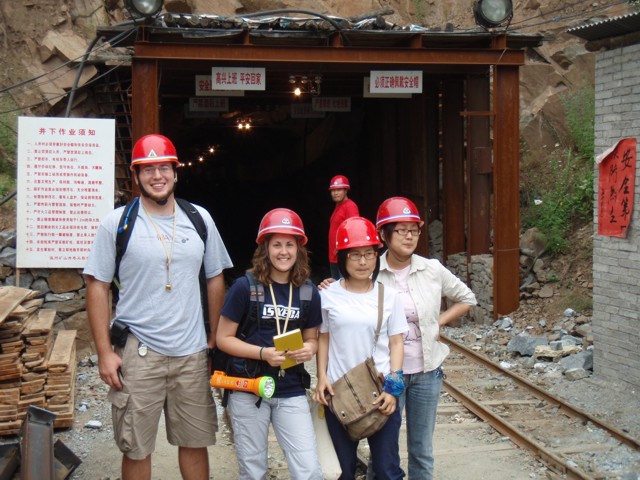
In the Qinling
Mountains of Henan province, Kutztown University undergraduate students Lauren
Storm and Anthony Moorehead studied the origins of a belt of
magmatic-hydrothermal molybdenum deposits. This work was in
collaboration with the China University of Geosciences in
Beijing. We traveled to Henan
province
in China in the summer of 2008 to aid in this work.
The trip was a cornucopia of fascinating lessons in Chinese
culture and frustrating lessons in... well... other aspects of Chinese
culture! David Muller and Michael Perrotta did excellent
follow-up microscope studies of these samples.

At Bayan
Obo, we are looking at chemical variations in the
limestone rocks that host the ore bodies to see if there is
evidence for influence by carbonatite magmas (either as
orthomagmatic lava flows and intrusions, or due to hydrothermal
activity related to carbonatite intrusions at depth). This
work is in collaboration with the China University of Geosciences
in Beijing. Three Kutztown University undergraduate students
(Zach Artz, Lisa Ferguson, and Kirsten Brown) traveled to Inner
Mongolia,
China with me in the summer of 2004 to do the field
work. Kelsey Mach, Alayna Rea, and Maggie Holman analyzed
the samples with both optical and electron microscopes for studies
presented at the Geological Society of America meetings in later
years.
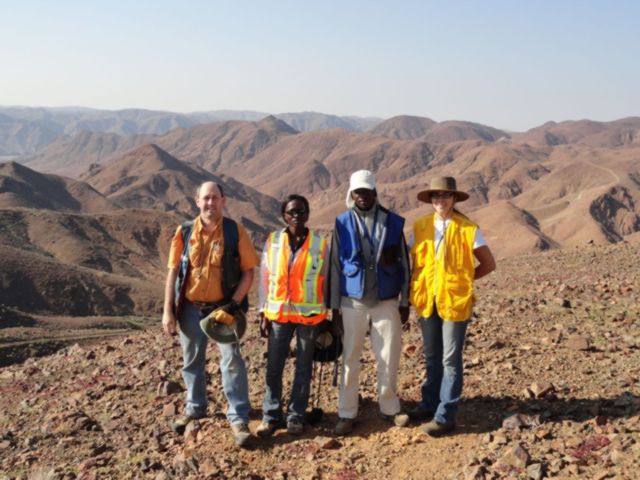
Kutztown undergraduate student Jewels Wilk accompanied me to the
southern Namibian desert to
study a 1.8 billion year old copper deposit.
This deposit is extraordinary in that the deposit is unusually
old and beautifully preserved! We spent three weeks at the
field site, plus several days in Windhoek where I gave a
presentation to the University of Namibia geology program. The Teck
geologists on the project were very smart and energized
people.
Petrographic and geochemical/isotope work on
this project is ongoing in the Kutztown University economic
geology / petrology lab with two students presenting their work
at the international Geological Society of America meeting in
Vancouver, British Columbia in October 2014.

On the Alaska project, three
Kutztown University undergraduate students (Melania Tkach, Dan
Ruth, and Ken Schlosser) worked with me in the Yukon-Tanana
uplands in the Alaskan interior doing geologic mapping with
follow-up microscope work on an ancient volcanic/geothermal site
that, sadly, failed to deposit much gold. The site is
therefore an opportunity to see why some gold-forming systems fail
to form ore bodies. The project was a collaboration with a
private company called Full Metal Minerals, Inc.
We also developed a
quantitative method for analyzing drill core to determine if the
�well� was drilled in a direction such that it approached
zinc mineralization.
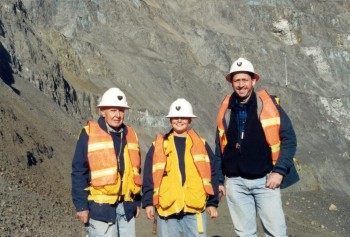
At Ertsberg
in West
Papua, Indonesia, my field mapping (1999-2002) revealed the
system to be hosted by several igneous phases that alternate in
time with multiple structural and hydrothermal events. I am
currently refining that work through petrographic studies aimed at
constraining the fluid chemistry, temperature, and pressure.
In collaboration with Dr.
Spencer Titley and Stacie Gibbins (University of Arizona),
we also studied some aspects of the origins of the giant Grasberg
porphyry copper deposit in the same district. Although the
Grasberg and Ertsberg porphyry deposits occur within 2 km of one
another and apparently formed within 100,000 years of one another
in relation to similar igneous rocks, metasomatism around the
Grasberg center is much more intense and widespread. The
ultimate goal of this project is to draw a comparison of
physiochemical conditions between these two contrasting systems to
identify some of the factors that affect how porphyry hydrothermal
systems evolve. Kutztown University undergraduate students
Emily Cook and Marley Rock both did outstanding work on these
deposits, which they presented at Geological Society of America
meetings.
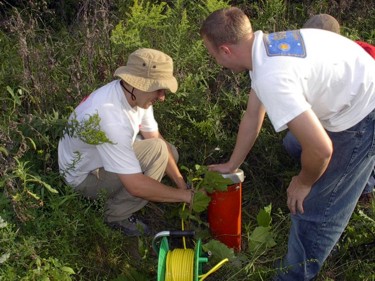
Sometimes my students are not interested in ore deposits, but
still seek the challenge of research. For this reason, we
have also investigated, in collaboration with the Berks Products
Corporation and Dr. Sarah Tindall, the geological controls on groundwater
flow and cave formation in
eastern
Pennsylvania. We compared hydrologic data such as changes
in groundwater table and groundwater chemistry
(temperature, pH, etc.) in a field of monitoring wells with rock
types and fracture patterns mapped in the adjacent quarry.
Our goal was to determine the relative importance of different
types of fractures, the abundance of fractures, and the
chemistry of the limestone rocks in affecting cave formation and
groundwater flow in the area.
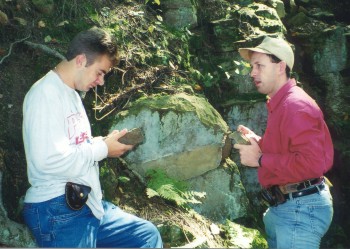
The focus of the magnetite (iron) deposits of the
eastern U.S. research was to determine if the Proterozoic
magnetite
deposits scattered throughout eastern Pennsylvania,
northern New Jersey, and southern New York are related to one
another and, if they are, learn what causes the subtle
variations in their geology. These old magnetite
deposits may be similar in origin to the much younger iron
deposits that occur in contact aureoles of plutons intruding the
Triassic/Jurassic rift basins nearby, which Rose et al. (1985)
proposed to be the result of hydrothermal activity related
to regional fluid flow of non-magmatic (basinal? evaporative?)
brines. The widespread scale of the many small magnetite
Proterozoic deposits, their relationship to hydrothermally
altered wall rocks, and the spatially systematic variation in
this alteration and the host rock types suggests the Proterozoic
deposits are related to the same general geologic event and that
different deposits formed at different depths. This work
was a collaboration with Dr. Robert C. Smith II (Pennsylvania
Geological Survey) and Richard Volkert (New Jersey Geological
Survey).
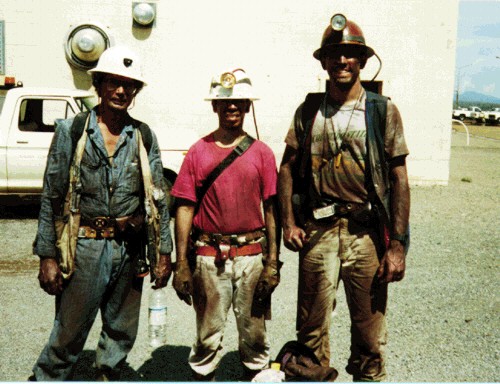
My Ph.D. research combined field mapping with detailed
petrographic studies, investigations of the carbon-oxygen isotope systematics in carbonate rocks,
and irreversible thermodynamic reaction path modeling to
document metasomatic reactions in carbonate rocks by fluids
given off during the late stages of the crystallization of
felsic magmas (i.e. porphyry copper deposits). These aqueous
solutions are analogous to those recorded in active geothermal
systems in volcanic arcs of the circumpacific (e.g. Pinatubo
Philippines and White Island New Zealand). The exposures
in the mine at Superior Arizona provided remarkable access to
the hydrothermal system there, allowing detailed study of 1) the
geology of carbonate-hosted massive sulfide replacement ores, 2)
factors affecting the relative sulfur, metal, and chlorine
budgets metalliferous solutions upon reaction with wall rocks,
and 3) the evaluation of stable isotopic tracers in determining
fluid flow paths in carbonate rocks.
Most recent publications
(names in italics indicate student co-authors)
Papers
- Qu
Hongying, Zhang Binwu, Friehauf, Kurt, Wang Hui, Chengyou
Feng, Dick, J.M., and Miao Yu, 2023, Apatite as a record
of ore-forming processes: Magmtic-hydrothermal evolution of
the Hutouya Cu–Fe–Pb–Zn ore district in the Qiman Tagh
Metallogenic Belt, NW China: Ore Geology Reviews, v. 154.
https://doi.org/10.1016/j.oregeorev.2023.105343
- Qu
Hongying, Friehauf, Kurt, Santosh, M., Pei Rongfu, Li Daxin,
Liu Jiannan, Zhou Shumin, Wang Hui,
2019, Middle-Late Triassic magmatism in the Hutouya
Fe-Cu-Pb-Zn deposit, East Kunlun Orogenic Belt, NW China:
Implications for geodynamic setting and polymetallic
mineralization: Ore Geology Reviews, v. 113,
- Volkert,
R.A.,
Monteverde,
D.H.,
Friehauf,
K.C.,
Gates, A.E., Dalton, R.F., and Smith, R.C., II, 2010,
Geochemistry and origin of Neoproterozoic ironstone deposits
in the New Jersey Highlands and implications for the eastern
Laurentian rifted margin in the north-central Appalachians,
USA: in Tollo,
R.P., Bartholomew , M.J., Hibbard, J.P., and Karabinos, P.M.,
eds., From Rodinia to
Pangea: The Lithotectonic Record of the Appalachian Region:
Geological Society of America Memoir 206, p. 283�306.
- Friehauf, K.C., 2008, Iron-sulfur
redox and its effect on sulfur-isotope fractionation in
carbonate-hosted Cu-Au replacement ores, Superior, Arizona, in Spencer, J.E., and Titley, S.R., eds., Ores and orogenesis: Circum-Pacific
tectonics, geologic evolution, and ore deposits: Arizona
Geological Society Digest 22, p. 583-590. (Tucson, AZ,
September 24-30, 2007)
- Mathur,
Ryan, Ruiz, Joaquin, Titley, Spencer R., Gibbins, Stacie L.,
and Friehauf, Kurt C., 2005, A detailed Re-Os isotope
study of ores and sediments from Ertsberg District:
Evidence linking porphyry copper mineralization to periphery
skarn mineralization and the importance of the surrounding
continental crust as a source for metals: Ore
Geology Reviews, v. 26, no. 3-4, p. 207-226.
- Friehauf,
Kurt, Gibbins, Stacie, and Titley, Spencer, 2005,
Porphyry-Style Mineralization in the Ertsberg Diorite, Gunung
Bijih (Ertsberg/Grasberg) District, West Papua, Indonesia: in Porter, T.M., ed., Super Porphyry
Copper & Gold Deposits - A Global Perspective, PGC
Publishing, Adelaide, Australia, v. 2, p. 357-366. (another great volume -
definitely worth checking out!) .
- Older
publications
Recent
Abstracts
- Perrotta,
Michael, and Friehauf, Kurt, 2022, Importance
of Retrograde skarn concentration of Mo from prograde skarn
in the Qiushuwan porphyry deposit, Henan, China [abs]:
Geological Society of America Annual Meeting in Denver, CO
(09-12 October 2022).
- Holman, Maggie, and Friehauf, Kurt, 2022, Characteristics
of hydrothermal inosilicate veins in the Bayan Obo REE
district, Inner Mongolia, China � A potential exploration
tool [abs]: Geological Society of America Annual Meeting
in Denver, CO (09-12 October 2022).
- Rea, Alayna, and Friehauf, Kurt, 2022, Possible
syngenetic sea-floor exhalative REE ores of Bayan Obo West
Ore Body, Inner Mongolia, China [abs]: Geological
Society of America Annual Meeting in Denver, CO (09-12 October
2022).
- Muller, David, Friehauf, Kurt, And Locmelis, Marek, 2019, Mineralogy
of high-grade Mo-skarn ore in the Qiu Shu Wan deposit,
Eastern Qinling Mineral Belt, Henan Province, China
[abs.]: Geological Society of America Annual Meeting in
Phoenix, AZ (20�25 September 2019).
- Domin, Mark R., Tindall, Sarah E., Eckert, Andreas, Friehauf,
Kurt, and Hogan, John P., 2019, Redistribution
of material in microfabrics associated with macroscopic
folding: Observations from the Jacksonburg Limestone,
Pennsylvania [abs.]: Geological Society of America
Annual Meeting in Phoenix, AZ (20�25 September 2019).
- Dinter, Eric R., Tindall, Sarah E., Eckert, Andreas, Friehauf,
Kurt, and Hogan, John P., 2019, Microfabric
characterization of folded pelites of the Windsor Township
Formation near Kutztown, PA [abs.]: Geological Society
of America Annual Meeting in Phoenix, AZ (20�25 September
2019).
- Doyle, Liam F., and Friehauf, Kurt, 2017, Detecting
hydrothermal alteration of coarse-grained igneous rock in
drill core with portable XRF: A case study in the Ertsberg
Porphyry District, Indonesia [abs.]: Geological Society
of America Annual Meeting in Seattle, WA (22�25 October
2017).
- Haag, Beau J., and Friehauf, Kurt, 2017, Pyrite-induced
redox precipitation of uranium in a dolomite breccia, Epler
Fm., Allentown, PA [abs.]: Geological Society of America
Annual Meeting in Seattle, WA (22�25 October 2017).
- Ilsemann, Lara,
Sulthaus, Danielle Shannon,
and Friehauf, Kurt, 2017, Comparison
of carbonate vein/dike with east ore body carbonate, Bayan
Obo REE Mining District, Inner Mongolia, China [abs.]:
Geological Society of America Annual Meeting in Seattle, WA
(22�25 October 2017).
- Maguire, Sara E., and Friehauf, Kurt, 2017, Reaction
path modeling of sulfur isotope fractionation during
progressive pyrite replacement of hematite, Superior C-Bed
Cu-Au Ore Body, Arizona [abs.]: Geological Society of
America Annual Meeting in Seattle, WA (22�25 October 2017).
- Malenda, Margariete, Friehauf, Kurt,
and Mathur, Ryan, 2014, Re-Os
isotopic dating of the Mesoproterozoic Haib porphyry copper
deposit, southern Namibia [abs.]: Geological Society of
America Annual Meeting in Vancouver, British Columbia (19�22
October 2014).
- Racosky, Alexandra and Friehauf, Kurt,
2014, Biotite
alteration in the Precambrian Haib porphyry copper district,
Namibia � Hydrogen isotope constraints on fluid origins
[abs.]: Geological Society of America Annual Meeting in
Vancouver, British Columbia (19�22 October 2014).
- Rock, Marlena; Mason,
Kelsey; Friehauf, Kurt,
2013, Lateral
Zonation of Gold Mineralogy in the Grasberg Porphyry Cu-Au
Deposit, Indonesia [abs.]: Geological Society of
America, Denver, Colorado (27�30 October, 2013).
- Mason, Kelsey; Rock,
Marlena; Friehauf, Kurt,
2013, Reconnaissance
Study of District-Scale Geochemical Trends in the Bayan Obo
REE District, Inner Mongolia [abs.]: Geological Society
of America, Denver, Colorado (27�30 October, 2013).
- Betts, T., Heness, E.A., Semian, Z.M.,
Malenda, M.G., Simpson,
E.L., and Friehauf, K.,
2013, A
unique occurrence of adipocere on the lacustrine shoreline,
Salton Sea California [abs.]: Geological Society of
America National Meeting, Denver, Colorado (27�30 October,
2013).
- Xiao, Ping; Friehauf, Kurt;
Wang, Wei; Yang, Guoliang; and Yun, Long, 2013, Donggou
Porphyry Mo deposit in East Qinling Mo Belt, China Highly
Enriched in Fluorine? [abs]: European Geosciences Union
General Assembly 2013, April 7-12, 2013, Vienna, Austria.
- Ruth, Daniel;
Schlosser, Kenneth; Tkach, Melania; Friehauf, Kurt;
and McLeod, Rob, 2012, Collaborative exploration of the
Mount Fairplay porphyry target - training undergraduate
students while searching for ore [abs]: AME BC Mineral
Exploration Roundup Conference, January 23-26, 2012 -
Vancouver, British Columbia.
- Xiao, Ping, Friehauf, Kurt,
Wang, Yanbin, and Wang, Cuizhi, 2010, The
implication of similarities and systematic variations among
the monometallic high-fluorine porphyry deposits in the East
Qinling Molybdenum Belt, China [abs]: Geological Society
of America, Denver, Colorado (31 October �3 November 2010).
- Older
publications

 Kurt Friehauf - Research
Kurt Friehauf - Research Kurt Friehauf - Research
Kurt Friehauf - Research







